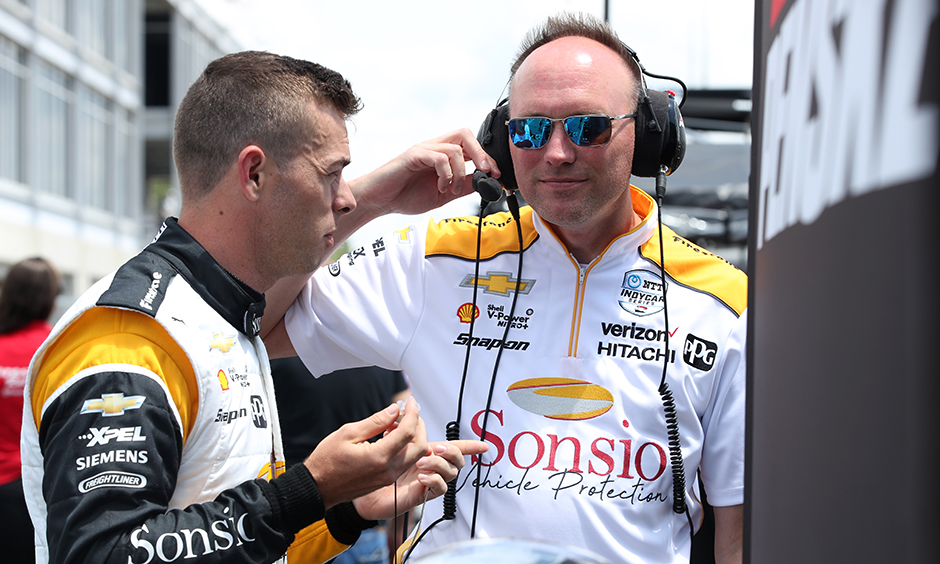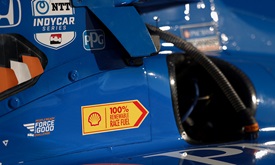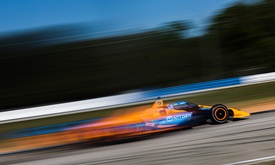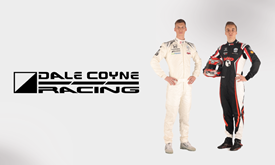The Setup: Streets of St. Petersburg, with Ben Bretzman
FEB 28, 2023
Note: This is a new series for INDYCAR.com, with different guests, leading into each race weekend for the NTT INDYCAR SERIES, focusing on various technical challenges of each respective circuit.
The NTT INDYCAR SERIES is opening up the 2023 season with this weekend’s Firestone Grand Prix of St. Petersburg presented by RP Funding.
The 1.8-mile street circuit consists of 14 turns (five left, nine right) and runs through parts of downtown and along a section of runway of Albert Whitted Airport. There will be two practice sessions and a qualifying bout ahead of Sunday’s 100-lap (181 miles) race set for noon ET (live, NBC, Peacock, Telemundo Deportes on Universo, INDYCAR Radio Network). The single lap qualifying record is held by Will Power, who put down a flyer of 59.3466 seconds, 109.189 mph on Feb. 26, 2022.
This week’s featured guest is Ben Bretzman, race engineer of the No. 3 DEX Imaging Team Penske Chevrolet that Scott McLaughlin drove to his first NTT INDYCAR SERIES victory in last year’s race on the Streets of St. Petersburg.
Q: What is it like preparing for St. Petersburg?
Ben Bretzman: The first race this season brings a lot of new things to go into the year with, in general. But for St. Pete, we’ve raced there for a lot of years now – 2005 was our first year there; Champ Car was there in '03, and then we started there '05. And there's a lot of a lot of laps around that track, which is a good thing from the standpoint of you get a general idea of what the track demands.
The circuit itself has changed a lot, particularly the last five or six years. A lot of sections have been paved and/or repaved, and it's become a really pretty grippy racetrack from a street course perspective. Obviously, we race a lot of different types of street courses, which can be anything from concrete, asphalt, a lot of epoxy-patched holes, a lot of things that are around a racetrack that can hold it together.
SEE: Scott McLaughlin’s 2022 Pole Lap in St. Petersburg
St. Pete has relatively fresh pavement around a lot of the track as of the last five or six years. So, it's a fast track and really grippy. The trick for St. Pete to other street courses is the corner durations are all short. There's a lot of short amount of time you're spending in corners - in these 90-degree corners; first- and second-gear corners. So, you have to manage lots of things happening with the car quickly because there's a lot of different braking dynamics and trying to get power down and have traction, all happening really quickly. Whereas places like Long Beach, the corners are a bit longer duration.
The track grip is a little bit different situation at St. Pete because the corner is so short and you’ve got to get rid of understeer there a lot more than other tracks, so you're always managing how much understeer you've got to get the front tires to work. And then the tricky part about it is it's also got some high-speed sections in it, and it's not all slow. If you look at Turn 3 at St. Pete, it's a relatively quick corner after you go down the front straightaway and you go through Turns 1 and 2 and then Turn 3, you're doing that at 130 mph.
Q: You’re referring to that switchback part of the track?
Bretzman: Yeah, exactly. It's a quick corner there and then Turns 11 and 12 – quick esses before you turn to get back on the runway there; that's also a 145-, 150-mph corner. It's not all low-speed racetrack there, so you’ve got to marry the two together. You look at Long Beach; there's no real high-speed corners there. It's a very different track. You look at Toronto; there's no high-speed corners there. The tallest gear corner you have there is maybe a third gear corner of Toronto, but there's not much there.
Whereas at St. Pete, you've got these high-speed corners that you have to deal with, and you have to have a lot of car stability through there. And then you’ve got a lot of low-speed corners that dictate you have a lot of understeer reduction, but from a setup perspective you can take understeer out of the slow speed corners and make the car handle better. But then what happens is in high-speed stuff, sometimes the car becomes less stable, and so then the driver is not as likely to push through the high-speed sections as much.
So, it becomes a very delicate balancing act of how you manage Turn 2, Turn 3, the quick chicane versus how do you manage Turn 4 through Turn 9, which is all really slow 90-degree corners. You’ve got to have a lot of front grip to make the corners work to roll speed through as best you can. Obviously, you make lap time in any car, but particularly in INDYCAR, obviously the less time you spend on the brake, the better. So, the sooner you can release the brake pedal and rely on the front grip of the tire, that's how you roll more speed and get a faster lap time.
There's a lot of that in St. Pete because you've got so many of these 90-degree corners; you got to be able to get off brake pedal and roll speed through. That's the part that makes it tricky in St. Pete: How do you manage the high-speed corners, make it drivable and stable, but also have enough front grip for all the slow speed sections to maximize lap time?
Q: Generally speaking, what type of setup do you lean toward and how is that different to other street circuits?
Bretzman: St. Pete, because it's a smoother track and it's got a bit more grip than like a Toronto or Nashville, you can get away with more there. You can get away with different platformed cars, whether that's in roll bars or whether that's in springs or in dampers. There's different ways to do it, but because the car is not bouncing around as much honestly as Nashville and Toronto, you can run a little bit stiffer typically somehow.
What's that do, right? That lets you lower the ride height of the car and take more advantage of what it is. It's an Indy car with a big wing underneath it and wings on the front and back, so it's making a lot of downforce. The more you can take advantage of that, you try to do as much as you can, so I think you try to take advantage of the fact that it's not a super bumpy racetrack and so whatever you need to do, do that.
Our St. Pete car looks a lot different than our Nashville car, even though we were ultra-successful with both of them and had a pole at both of them. They're very different cars because of what those circuits are. Nashville being very bumpy, you’ve got to have a bit more compliant car and the car is flying all over the place because it's going over these bumps, so you’ve got to manage that versus you can be a bit more aggressive with the setup at St. Pete because it's a smoother track. So, use the Indy car for what it is. It's a big downforce generator, keep it close to the ground and try to maximize that as best you can.
Q: Car balance is always one of the trickiest parts with anywhere we go, so where do you determine driver comfort versus sacrificing maximum lap time?
Bretzman: Any driver is going to say it must be perfect in every corner, and St. Pete is not too terrible from that standpoint. You can marry it all together well. I think where it could be difficult at St. Pete – and I think what differentiates cars from each other – is basically what I just said previous is and what you're alluding to is if a driver's not very comfortable in the high-speed sections and you have to keep adding more and more rear stability to the car, the lap time in between Turn 4 and Turn 9 is going to evaporate. There'll be nothing left of it because you won't have enough front grip to drive through there to release the brake pedal.
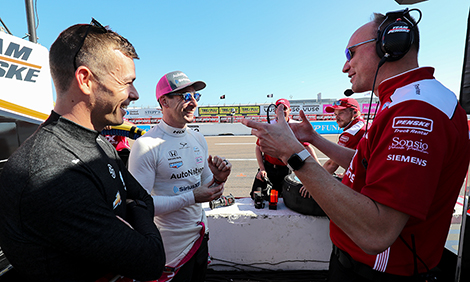 It's somewhat driver dependent, but there's ways to marry it. I think the St. Pete cars are slightly different than our other street-course cars because the demands aren't as much. At Nashville, for instance, since we're talking street courses, traction is a really big thing. The track's so bumpy, and stability and traction are important there.
It's somewhat driver dependent, but there's ways to marry it. I think the St. Pete cars are slightly different than our other street-course cars because the demands aren't as much. At Nashville, for instance, since we're talking street courses, traction is a really big thing. The track's so bumpy, and stability and traction are important there.
Whereas at St. Pete, it's really more about understeer reduction to the point where the car is stable enough through the high-speed sections. Most of the time you have enough traction there because the track's got enough grip in it and the tires that Firestone brings have enough grip in it, the traction is not a massive concern.
Don't get me wrong: It's a thing that you worry about, but it's lower on the priority list than just trying to get understeer out. I don't think you'll really sacrifice the setup too much. I think the track just naturally takes you to having to get understeer out of the car at St. Pete.
Q: Does the track tend to get grippier over the course of the weekend or is it the type of place that loses grip as things go on?
Bretzman: St. Pete does get a little better through the weekend. For us, it's so dependent on what's running before us. To give an example, Long Beach we run after the IMSA cars run, so when we roll out Friday after it was all IMSA running the track. The track's pretty clean and there's a lot of grip, so there's not as much evolution there, but at St. Pete there is some, for sure.
There's just not as many cars running beforehand, so there's definitely track evolution. Not as much as Toronto and Nashville because those two are lower-grip tracks. There's a lot more to be gained there to put rubber down on the surface. Whereas St. Pete, because it's getting a lot smoother than it has been in the past and there's a lot of new asphalt down, the way that the surface is there, it's got a lot of grip to start with. So, there's some evolution, but it's not massive.
Q: With Firestone also being the official tire supplier and partner of INDY NXT by Firestone, the top development category of the NTT INDYCAR SERIES, do you think that’ll prove more complimentary to grip since it is similar?
Bretzman: I don't know exactly myself either, but I think it's very, very close to what we're running. So, even tire construction - sides and what they are - is very close to what we run. So, yeah, I think where you're going with this is, I think that's going to help us even more.
I remember back 10 years ago when we used to run Firestones on the small cars, that would just always help no matter what. And so, I think having the same compound and honestly, there's so many, nearly 20 INDY NXT cars now, that's going to drastically help also at St. Pete because they're going to be busy running a lot of cars out there, which helps us. But it's just because of how the asphalt is so pretty fresh there, it's not beat up or broke apart too much, it's got a lot of grip right now.
Yeah, the INDY NXT stuff will certainly help us. It's just very different than Nashville or Toronto because they are so bumpy and so low grip on so many surfaces that it takes a while to get rubber put down and then it keeps growing, so the track evolution's big at those places.
Q: What is the most difficult section of St. Pete?
Bretzman: The toughest ones are -- it's probably setup and driver related -- probably Turn 4 and Turn 5, and qualifying is always a little tricky. Turn 4 is off the short straight after the (Turns) 1-2-3 section, and that corner typically always has some rear locking in it when you're really pushing the brake zone deep for qualifying. Depending on how you roll through Turn 4 almost sets up how the rest of those sections of those corners you're going to do. You can brake early for Turn 4 and then try to roll more speed and then you end up pushing wider for Turn 5. Then, that then dictates your entry line and pace into (Turns) 8 and 9, and there's a lot of time to be gained there if you can get that whole section right.
Sometimes a lot of it is dictated by how well your car is braking into Turn 4 and how aggressive you can be with it there. So that, I'd say, is how your approach is to (Turn) 4 and then how well your car's turning through that entire section there is going to dictate a lot of the lap time.
Q: Scott McLaughlin drove a hell of a race last year to get his first career win in the NTT INDYCAR SERIES. When you look at that, was there anything dramatically different from a setup standpoint than in maybe what you encountered previously?
Bretzman: Yeah, last year because I just started working with Scott. Earlier in the offseason, we looked over what he did in 2021 and he'd also raced at St. Pete in 2020, so we knew what we had with him there.
We were able to sit down, and it sounds funny, but we basically reinvented the wheel for him on what he wanted to have out of a race car. He had certain things that he was used to driving and certain ways that he liked to push the brake pedal or how fast he wanted to move his hands or how much he wanted to move his hands, how he wanted to feel the front tires and where he wanted stability in the corner, and we could really dissect that since he had a season of data.
Then it's our job to basically take that back and put it in a mixing pot and figure out, well how do we satisfy all these requests with what we've got for a race car? So, we changed quite a bit on his car last year from where we were the previous years and at the street courses, in general.
Like I said, a lot of it was just how do we make him happy based off what he's experienced so far? He's obviously coming out of Supercars racing, and they brake very differently than how we brake and the grip available is different, so what he feels and what he perceives as a car is doing, you don't want to make the Indy car the performance of a Supercar, but how you make these sensations or slides or things that he's used to similar, right?
And so, we went down this path of, ‘OK, well we know a couple things on the car that will do exactly what he wants to do.’ Then we took those and we basically would set that static and we wouldn't change those. We changed a bunch of other parts on the car and tried to figure out what worked and what didn't work, whether that's through like simulation or driver simulation and then testing in the offseason. Then, we basically came up with a soup (setup) for him that he liked. It was just going through certain things that we knew he really wanted to have in his race car.










